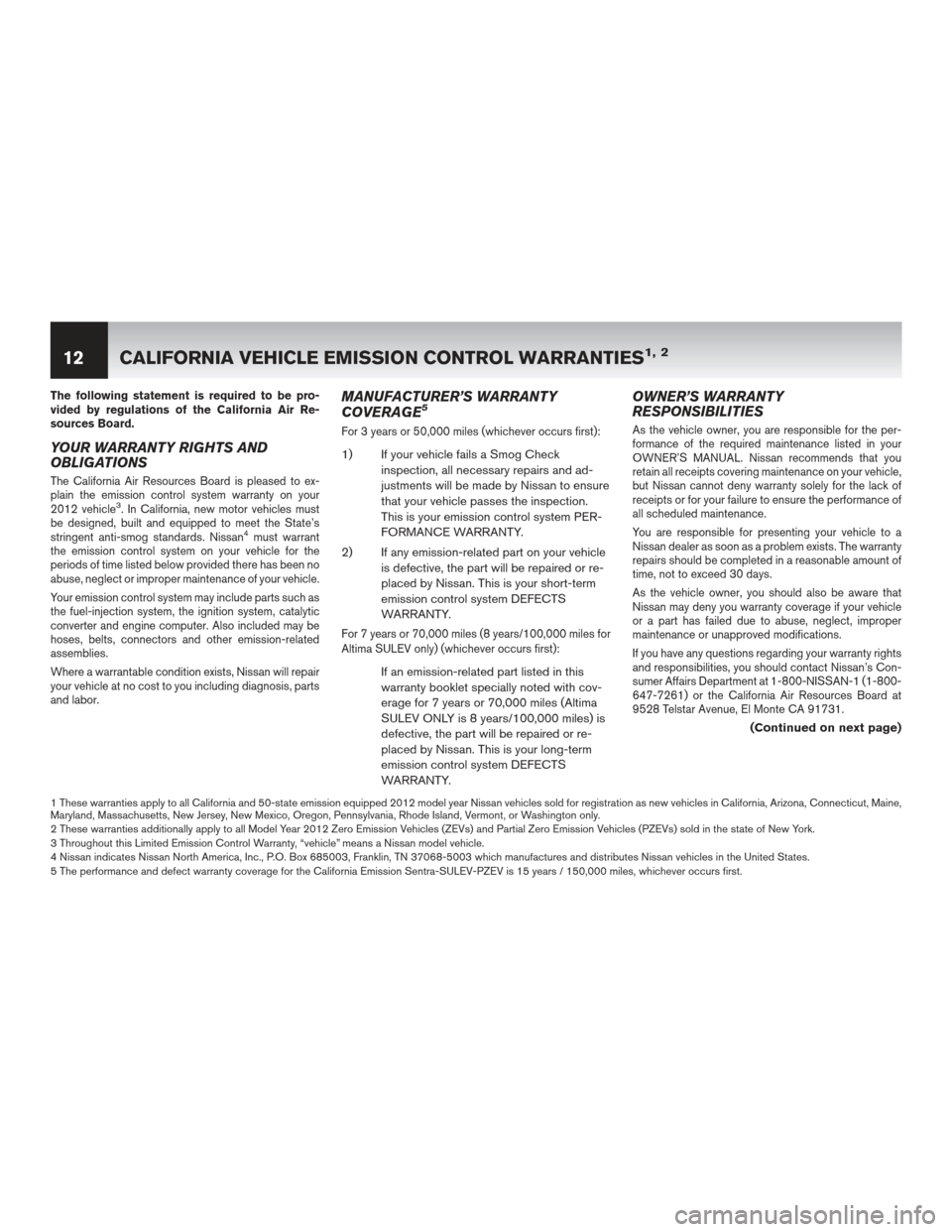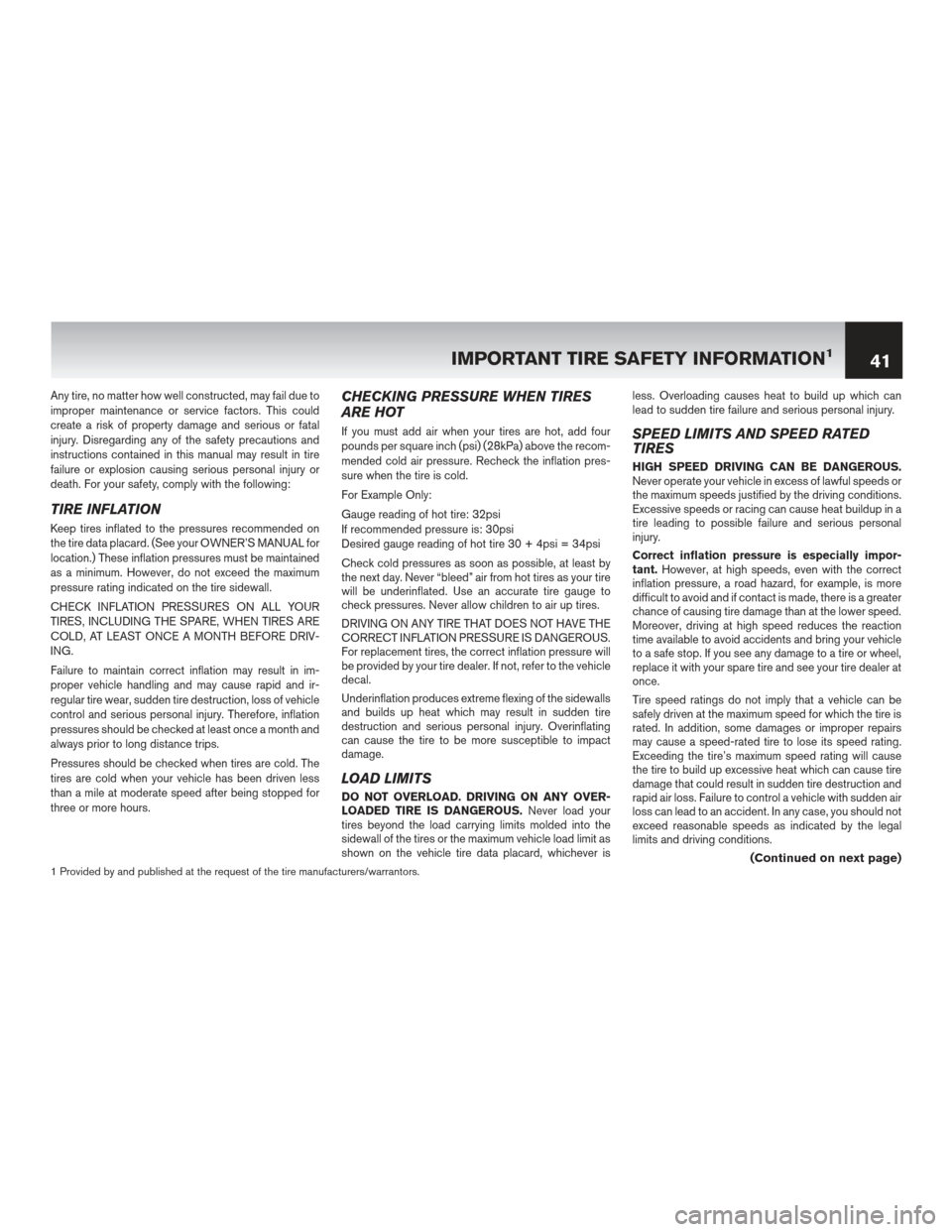ECO mode NISSAN VERSA 2012 1.G Warranty Booklet
[x] Cancel search | Manufacturer: NISSAN, Model Year: 2012, Model line: VERSA, Model: NISSAN VERSA 2012 1.GPages: 61, PDF Size: 0.36 MB
Page 16 of 61

The following statement is required to be pro-
vided by regulations of the California Air Re-
sources Board.
YOUR WARRANTY RIGHTS AND
OBLIGATIONS
The California Air Resources Board is pleased to ex-
plain the emission control system warranty on your
2012 vehicle
3. In California, new motor vehicles must
be designed, built and equipped to meet the State’s
stringent anti-smog standards. Nissan
4must warrant
the emission control system on your vehicle for the
periods of time listed below provided there has been no
abuse, neglect or improper maintenance of your vehicle.
Your emission control system may include parts such as
the fuel-injection system, the ignition system, catalytic
converter and engine computer. Also included may be
hoses, belts, connectors and other emission-related
assemblies.
Where a warrantable condition exists, Nissan will repair
your vehicle at no cost to you including diagnosis, parts
and labor.
MANUFACTURER’S WARRANTY
COVERAGE5
For 3 years or 50,000 miles (whichever occurs first):
1) If your vehicle fails a Smog Check
inspection, all necessary repairs and ad-
justments will be made by Nissan to ensure
that your vehicle passes the inspection.
This is your emission control system PER-
FORMANCE WARRANTY.
2) If any emission-related part on your vehicle is defective, the part will be repaired or re-
placed by Nissan. This is your short-term
emission control system DEFECTS
WARRANTY.
For 7 years or 70,000 miles (8 years/100,000 miles for
Altima SULEV only) (whichever occurs first):
If an emission-related part listed in this
warranty booklet specially noted with cov-
erage for 7 years or 70,000 miles (Altima
SULEV ONLY is 8 years/100,000 miles) is
defective, the part will be repaired or re-
placed by Nissan. This is your long-term
emission control system DEFECTS
WARRANTY.
OWNER’S WARRANTY
RESPONSIBILITIES
As the vehicle owner, you are responsible for the per-
formance of the required maintenance listed in your
OWNER’S MANUAL. Nissan recommends that you
retain all receipts covering maintenance on your vehicle,
but Nissan cannot deny warranty solely for the lack of
receipts or for your failure to ensure the performance of
all scheduled maintenance.
You are responsible for presenting your vehicle to a
Nissan dealer as soon as a problem exists. The warranty
repairs should be completed in a reasonable amount of
time, not to exceed 30 days.
As the vehicle owner, you should also be aware that
Nissan may deny you warranty coverage if your vehicle
or a part has failed due to abuse, neglect, improper
maintenance or unapproved modifications.
If you have any questions regarding your warranty rights
and responsibilities, you should contact Nissan’s Con-
sumer Affairs Department at 1-800-NISSAN-1 (1-800-
647-7261) or the California Air Resources Board at
9528 Telstar Avenue, El Monte CA 91731.
(Continued on next page)
1 These warranties apply to all California and 50-state emission equipped 2012 model year Nissan vehicles sold for registration as new vehicles in California, Arizona, Connecticut, Maine,
Maryland, Massachusetts, New Jersey, New Mexico, Oregon, Pennsylvania, Rhode Island, Vermont, or Washington only.
2 These warranties additionally apply to all Model Year 2012 Zero Emission Vehicles (ZEVs) and Partial Zero Emission Vehicles (PZEVs) sold in the state of New York.
3 Throughout this Limited Emission Control Warranty, “vehicle” means a Nissan model vehicle.
4 Nissan indicates Nissan North America, Inc., P.O. Box 685003, Franklin, TN 37068-5003 which manufactures and distributes Nissan vehicles in the United States.
5 The performance and defect warranty coverage for the California Emission Sentra-SULEV-PZEV is 15 years / 150,000 miles, whichever occurs first.
12CALIFORNIA VEHICLE EMISSION CONTROL WARRANTIES1, 2
Page 45 of 61

Any tire, no matter how well constructed, may fail due to
improper maintenance or service factors. This could
create a risk of property damage and serious or fatal
injury. Disregarding any of the safety precautions and
instructions contained in this manual may result in tire
failure or explosion causing serious personal injury or
death. For your safety, comply with the following:
TIRE INFLATION
Keep tires inflated to the pressures recommended on
the tire data placard. (See your OWNER’S MANUAL for
location.) These inflation pressures must be maintained
as a minimum. However, do not exceed the maximum
pressure rating indicated on the tire sidewall.
CHECK INFLATION PRESSURES ON ALL YOUR
TIRES, INCLUDING THE SPARE, WHEN TIRES ARE
COLD, AT LEAST ONCE A MONTH BEFORE DRIV-
ING.
Failure to maintain correct inflation may result in im-
proper vehicle handling and may cause rapid and ir-
regular tire wear, sudden tire destruction, loss of vehicle
control and serious personal injury. Therefore, inflation
pressures should be checked at least once a month and
always prior to long distance trips.
Pressures should be checked when tires are cold. The
tires are cold when your vehicle has been driven less
than a mile at moderate speed after being stopped for
three or more hours.
CHECKING PRESSURE WHEN TIRES
ARE HOT
If you must add air when your tires are hot, add four
pounds per square inch (psi) (28kPa) above the recom-
mended cold air pressure. Recheck the inflation pres-
sure when the tire is cold.
For Example Only:
Gauge reading of hot tire: 32psi
If recommended pressure is: 30psi
Desired gauge reading of hot tire 30 + 4psi = 34psi
Check cold pressures as soon as possible, at least by
the next day. Never “bleed” air from hot tires as your tire
will be underinflated. Use an accurate tire gauge to
check pressures. Never allow children to air up tires.
DRIVING ON ANY TIRE THAT DOES NOT HAVE THE
CORRECT INFLATION PRESSURE IS DANGEROUS.
For replacement tires, the correct inflation pressure will
be provided by your tire dealer. If not, refer to the vehicle
decal.
Underinflation produces extreme flexing of the sidewalls
and builds up heat which may result in sudden tire
destruction and serious personal injury. Overinflating
can cause the tire to be more susceptible to impact
damage.
LOAD LIMITS
DO NOT OVERLOAD. DRIVING ON ANY OVER-
LOADED TIRE IS DANGEROUS.Never load your
tires beyond the load carrying limits molded into the
sidewall of the tires or the maximum vehicle load limit as
shown on the vehicle tire data placard, whichever is less. Overloading causes heat to build up which can
lead to sudden tire failure and serious personal injury.
SPEED LIMITS AND SPEED RATED
TIRES
HIGH SPEED DRIVING CAN BE DANGEROUS.
Never operate your vehicle in excess of lawful speeds or
the maximum speeds justified by the driving conditions.
Excessive speeds or racing can cause heat buildup in a
tire leading to possible failure and serious personal
injury.
Correct inflation pressure is especially impor-
tant.
However, at high speeds, even with the correct
inflation pressure, a road hazard, for example, is more
difficult to avoid and if contact is made, there is a greater
chance of causing tire damage than at the lower speed.
Moreover, driving at high speed reduces the reaction
time available to avoid accidents and bring your vehicle
to a safe stop. If you see any damage to a tire or wheel,
replace it with your spare tire and see your tire dealer at
once.
Tire speed ratings do not imply that a vehicle can be
safely driven at the maximum speed for which the tire is
rated. In addition, some damages or improper repairs
may cause a speed-rated tire to lose its speed rating.
Exceeding the tire’s maximum speed rating will cause
the tire to build up excessive heat which can cause tire
damage that could result in sudden tire destruction and
rapid air loss. Failure to control a vehicle with sudden air
loss can lead to an accident. In any case, you should not
exceed reasonable speeds as indicated by the legal
limits and driving conditions.
(Continued on next page)1 Provided by and published at the request of the tire manufacturers/warrantors.
IMPORTANT TIRE SAFETY INFORMATION141